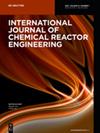入口水蒸气质量分数对拉瓦尔喷嘴流动特性的影响
IF 1.2
4区 工程技术
Q4 ENGINEERING, CHEMICAL
International Journal of Chemical Reactor Engineering
Pub Date : 2024-07-02
DOI:10.1515/ijcre-2024-0039
引用次数: 0
摘要
摘要 拉瓦尔喷嘴是超音速旋流器实现气液两相变化的重要部件,拉瓦尔喷嘴的冷凝特性对超音速旋流器的分离性能有重要影响。本文通过建立空气-水蒸气超音速冷凝流三维数值模型,采用数值模拟和实验方法研究了入口水蒸气质量分数对拉瓦尔喷嘴冷凝特性的影响。研究了不同入口水蒸气质量分数下拉瓦尔喷嘴的流场结构,包括马赫数、压力和温度,并研究了入口水蒸气质量分数对拉瓦尔喷嘴液化特性的影响。此外,拉瓦尔喷嘴中的液滴分布也通过粒子图像测速(PIV)实验系统进行了测试。模拟和实验结果的对比表明,本文建立的数值模型能够有效地描述拉瓦尔喷嘴中的实际流动情况。结果表明,入口水蒸气质量分数对拉瓦尔喷嘴中的流场结构影响较小,而对水蒸气冷凝特性影响较大。当进口蒸汽质量分数从 5 % 增加到 12.5 % 时,拉瓦尔喷嘴中的成核率、液滴数和分离效率分别增加到 4.05 × 1021 kg-1 s-1、3.67 × 1014 kg-1 和 79.4 %,当进口蒸汽质量分数进一步增加到 15 % 时,这些参数都有所下降。本文章由计算机程序翻译,如有差异,请以英文原文为准。
Effect of inlet water vapor mass fraction on flow characteristics in Laval nozzle
Abstract The Laval nozzle is an important component of the supersonic cyclone to achieve the change of gas–liquid two-phase, and the condensation characteristics of the Laval nozzle have an important influence on the separation performance of the supersonic cyclone. In this work, the effect of inlet water vapor mass fraction on the condensation characteristics in the Laval nozzle was investigated using numerical simulation and experimental methods by establishing a three-dimensional numerical model of air-water vapor supersonic condensation flow. The flow field structures in the Laval nozzle under different inlet water vapor mass fractions were investigated, including Mach number, pressure, and temperature and the effects of the inlet water vapor mass fraction on the liquefaction characteristics in the Laval nozzle were investigated. In addition, the droplet distribution in the Laval nozzle were also tested by a particle image velocimetry (PIV) experimental system. The comparison of simulation and experimental results indicates that the numerical model established in this work can effectively describe the real flow situation in the Laval nozzle. The results show that the inlet water vapor mass fraction has a little effect on the flow field structure in the Laval nozzle, and has the significant impact on the water vapor condensation characteristics. With increasing the inlet steam mass fraction from 5 % to 12.5 %, the nucleation rate, droplet number, and separation efficiency in the Laval nozzle increase to 4.05 × 1021 kg−1 s−1, 3.67 × 1014 kg−1, and 79.4 %, respectively, and when further increasing the inlet steam mass fraction to 15 %, these parameters decrease.
求助全文
通过发布文献求助,成功后即可免费获取论文全文。
去求助
来源期刊

International Journal of Chemical Reactor Engineering
ENGINEERING, CHEMICAL-
CiteScore
2.70
自引率
12.50%
发文量
107
审稿时长
6-12 weeks
期刊介绍:
The International Journal of Chemical Reactor Engineering covers the broad fields of theoretical and applied reactor engineering. The IJCRE covers topics drawn from the substantial areas of overlap between catalysis, reaction and reactor engineering. The journal is presently edited by Hugo de Lasa and Charles Xu, counting with an impressive list of Editorial Board leading specialists in chemical reactor engineering. Authors include notable international professors and R&D industry leaders.
 求助内容:
求助内容: 应助结果提醒方式:
应助结果提醒方式:


